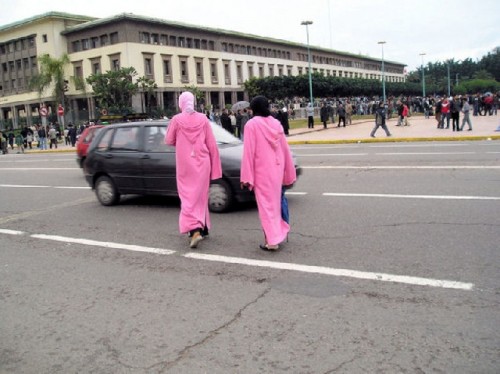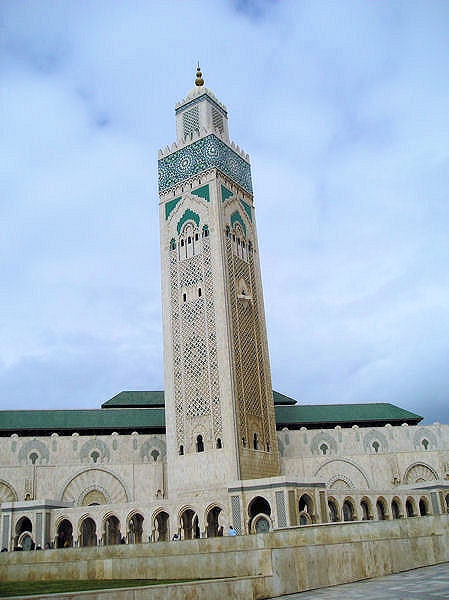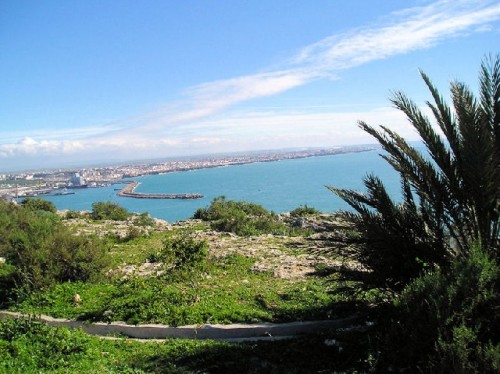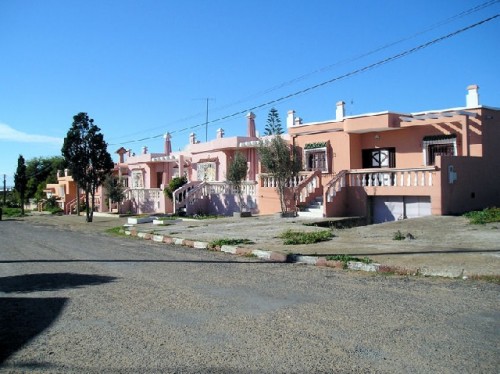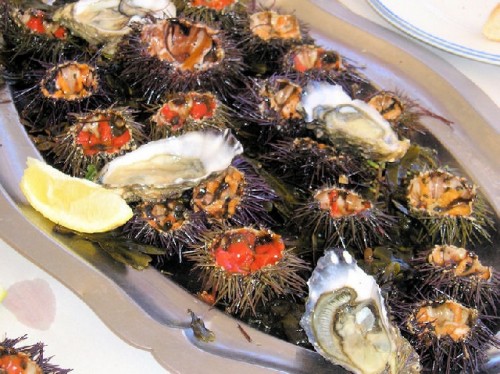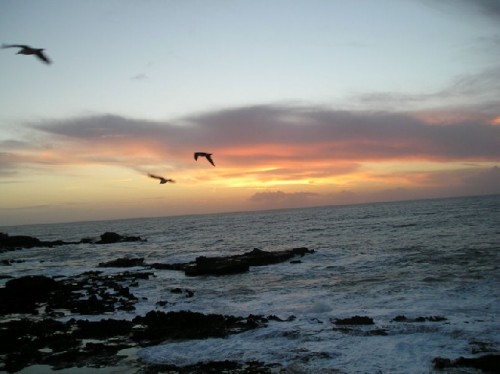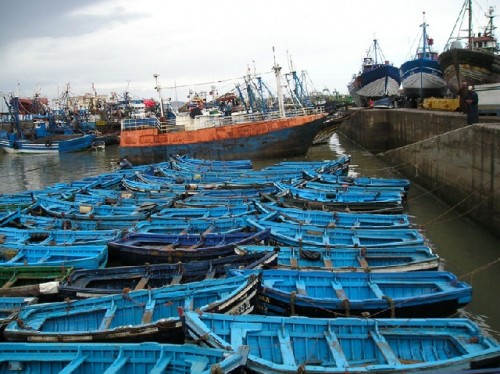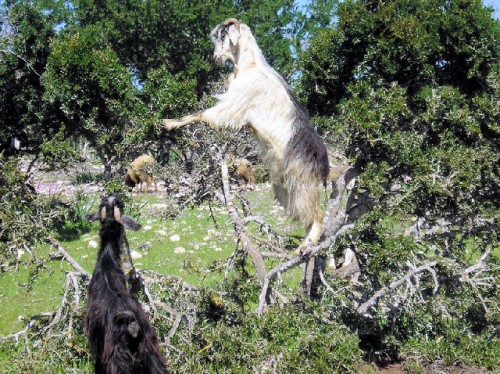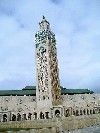Morocco: Part One
Casablanca to Essaouira
By: Zeren Earls - Dec 18, 2007
My quest to discover distant lands took me to Morocco in February-March of 2006. The three week tour with Overseas Adventure Travel traversed the country from the Atlantic coast to the Atlas mountains and included camping in the Sahara desert. The $3000 cost covered airfare, lodging and most meals.
Shortly after I arrived at Boston's Logan airport it began snowing, delaying my flight to New York. One hour later than the scheduled departure, I finally boarded, only to find out that the plane had to be deiced before take-off. The snow seemed to freeze as soon as it hit the ground and frosted my window until I could no longer see out. Airborne after a two-hour delay, the Delta plane quickly rose above the clouds, easing my anxiety about missing the connection to Casablanca, as I had allowed four hours in between flights.
As I walked down the aisle to my seat on Royal Air Maroc, incense permeated the air. Some of the passengers were in flamboyant African dress, others in modest Arab garb. I settled next to a Moroccan from Brooklyn, who was going home to visit his sick father. Over the nine hours of our trip, one of which was spent on the ground waiting for clearance, he talked about growing up in Morocco. His story, engaging as a good book, was steeped in the colors, flavors and people of his country. One of eight children, all of whom had dispersed throughout the world to earn a living, he had gone to school in France, then in Canada, and finally settled in the United States with a green card. He managed the restaurant of a hotel that catered to Jewish families in Brooklyn.
Casablanca
As we cleared customs our trip leader, Aziz, met our group of nine, who had signed up for the pre-trip to Essaouira, an ancient walled city on the Atlantic coast. Dressed in a black skullcap and brown jalaba, the traditional long garb worn by Moroccan men and women, he welcomed us to our "second home", informing us that Morocco had been the first country to recognize the United States after the Civil War. On the way to our hotel we passed red flags with green stars, red symbolizing the blood shed for independence from France in 1956, and the five-pointed star the pillars of Islam.
Casablanca, a bustling, modern port with a population of 5 million is Africa's second largest city after Cairo. It is the industrial capital, where 70% of the country's industry is located. It is on the same latitude as California and enjoys a similar climate. 80% of its power is generated by hydroelectricity, the remainder by coal. People drive mostly diesel or small French cars due to the high cost of gasoline ( $12 a gallon. All of the taxis are old Mercedes cars referred to as "German camels" by the people.
Our main excursion was to the Hassan II Mosque, second only to Mecca as the largest religious monument anywhere. Inspired by the Koranic verse "The Throne of God was on water," His Majesty the late Hassan II had it erected partly on water. This grand edifice of the 20th century, built by public donations, sits at the edge of the Atlantic Ocean, its 200-meter-high minaret visible from all corners of the city. The prayer hall, holding 25,000, has a movable roof, which accommodates 100,000 worshippers when raised. Two hanging mezzanines with fine carvings are reserved for women. The ablution hall with 41 fountains and the two tiled baths are the jewels of this Arab-Islamic architecture. The boardwalk of Casablanca is called "La Corniche," French being Morocco's dominant language. We strolled along the boardwalk lined with teahouses, fish restaurants and even a MacDonald's. The Sunday promenade with children in tow blended modest Arab elegance with African flair, as women in jalabas of somber tones walked about sporting headscarves in bright blue, lime green or saffron. Those with dark head covers wore lavender or pink jalabas, delighting to the unaccustomed eye.
The white cityscape gives Casablanca its unique character. True to its name, which means, "white house" in Portuguese, all houses are painted white. Its City Hall Square is a major gathering place, where people congregate to socialize and watch the fountain light up. To get to the square one has to scramble across a wide boulevard through heavy traffic, which does not stop for pedestrians.
Our first meal in the hotel was one of many memorable culinary experiences we had throughout the trip. At the center the table featured the customary dates with lemon, followed by harira, a thick, spiced soup made of lentils and chickpeas. The main course was tajine of beef braised with prunes and onions and served with a hard-boiled egg on the side. We mopped up the juices with chunks torn from freshly baked round loaves of khobra bread. The meal concluded with thinly sliced oranges sprinkled with cinnamon.
Essaouira
The next morning we traveled 340 km. south, taking the scenic route along the coast. Small orange, yellow and purple flowers on the way turned into freshly plowed fields separated by serpentine walls of field rocks or cacti, with flocks of sheep and cows grazing in lush green pastures ending at the shoreline. We stopped by the roadside to watch men unload a truckload of mud-covered carrots into a pool of water, agitating it with their feet to wash off the mud. Women carried big bundles of brush for firewood on their heads; men rode donkey-drawn carts, as young men with fishing rods speeded by.
The Atlantic coast is dotted with resorts; however, it was still early for the summer buzz. We stopped at a seafood restaurant for lunch. As soon as the platter of fresh oysters and sea urchins arrived as an appetizer, we all reached for our cameras to document this incredible display. Since eating a sea urchin was a new experience for me, I had to learn how to scoop out its roe. The main coarse was fried sardines, flounder and red snapper, followed by orange tart with the rind intact.
Berber herders waved to us as we resumed our trip. Children came running to earn a few dirhams in exchange for a photo op. We drove by plastic-covered greenhouses, surf breaking on the shore, and tombs scattered in the fields. When we reached Safi, a coastal town whose major industries are phosphate and sardines, the landscape changed into one of earth-toned houses with bright colored doors and window frames. Flat roofs featured green tiles and slender chimneys. The weather felt much warmer as the blooming mimosa and hibiscus trees came into view. We stopped outside the main gate of the Essaouira medina, the walled medieval city, as vehicles cannot negotiate its narrow streets. Porters unloaded our luggage onto two wheeled carts, which they pulled by hand through the narrow streets to our hotel. Its massive gate did not reveal what lay beyond.
Three stories of balconies encircled a luxuriant interior patio with a central fountain under a skylight. On the first floor a library and sitting nooks, carpeted with straw mats supporting low mosaic tables on wrought iron stands, opened to the patio. Moroccan crafts adorned the walls. Our morning began here with fresh squeezed orange juice, crepes with honey, croissants and coffee.
A fascinating harbor walk took us by fishing boats, fishermen mending nets, and seagulls perched on seawalls. We stopped at the wholesale fish market and watched fish, including eels, being auctioned to retailers. For lunch we bought our own fish by the kilo and had it grilled at one of the roadside restaurants. We enjoyed shrimp, two kinds of squid and sea bass, accompanied by a salad of tomatoes and onions, along with freshly baked bread. We ate with our hands like the locals.
In the afternoon we visited the Argan Oil Cooperative, which benefits poor women. The Argan, native to Morocco, is similar to an olive tree. Goats eat the fruit; the pits are used to process oil for cosmetic or medicinal purposes. By hand women skin the fruit, crack the nuts, roast the seeds, and then squeeze them to get the oil. The pits are either roasted or cold-pressed, depending on the intended product. After sampling the delicious almond paste mixed with argan oil and honey, we purchased some along with salad oil and soap.
In the afternoon we walked the narrow alleys of the medina, which has different sections: a mosque, medresa (religious school), fountain, hamam (public bath) and baking ovens. Women make the bread at home, inscribe the family name into the bottom of the loaf, and send it out for baking. The aroma of fresh baked bread on the streets reminded me of my childhood in Turkey. Many women still go to a hamam for the day to socialize and to look for suitable brides for their sons.
Thuya wood is unique to Morocco; Essaouira is renowned for this woodcraft. Thuya is a dark, deeply knotted wood. Often it is combined with lemon wood or ebony. During our visit to the artisan cooperative we watched men trace a design on the wood, cut around the stencil and fill it in with lighter-colored wood or mother-of-pearl. I liked the rich grain of the wood, so that all my souvenirs are carved from solid thuya.
The sunset over the Atlantic was the highlight of the day. I sat on the wall near the ocean, watching the blue sky shift into streaks of orange, red, yellow, pink and deep purple. The vast canvas of color formed a backdrop to flying seagulls that seemed to be rushing home to beat the night. I took two-dozen photos until the sun was no longer at the horizon.
Market day is a big day. We traveled south to observe the Wednesday market, where donkeys and sheep were on sale. Sheep were slaughtered on the spot and carried home in deep baskets secured to donkeys. Children accompanied parents to load up the donkeys. The produce section was a chaotic display of tomatoes, turnips, carrots, onions, potatoes, oranges and spices, all spread over sheets of plastic on the ground. Other items for sale were bolts of fabric, shoes made of recycled tires, clay pots and decorated ceramic urns. Men got a shave and a haircut in tented barbershops, while donkeys got fitted for horseshoes. An arbitration court of elders settled disputes between merchants.
The visit to a grove of argan trees to see the goats feeding was delightful. Big and little goats stood on their hind legs to reach the fruit and climbed the branches to get to the ones higher up. Easy to spot in their shaggy brown, white and black hair, they allowed me to get close to take pictures as they continued eating. It seems they were accustomed to being photographed for they appear on many postcards. Afterwards by the beach, we enjoyed shish kebab cooked over a charcoal brazier and seasoned with cumin.
Following three days in picturesque Essaouira, lined with its orange trees, whitewashed buildings with blue doors, horse-drawn carts and a panorama of beaches, we headed back to Casablanca via an alternate route through the countryside. As we entered the city, the languid character of the south gave way to pollution and noise. Women's attire ranged from the tightest jeans and stiletto shoes to long coats and jalabas. Aziz suggested we check out Rick's bar at the Hyatt Hotel, also advising us, when crossing the street just to begin walking, thus forcing the traffic to stop. The bar, an imitation from the movie Casablanca, featured a piano and pictures of Humphrey Bogart and Ingrid Bergman.
In the morning we traded our van for a bus to accommodate our full group of sixteen and before leaving for the main tour starting in Rabat, visited an indoor market. Small butcher shops featured signs in French, each identifying the kind of meat sold: horse, beef or chicken. Others sold live turtles, snails, fish and exotic produce such as truffles, kumquats and small bananas. The variety of dates and the assortment of green, black and red olives were picture-book displays.

